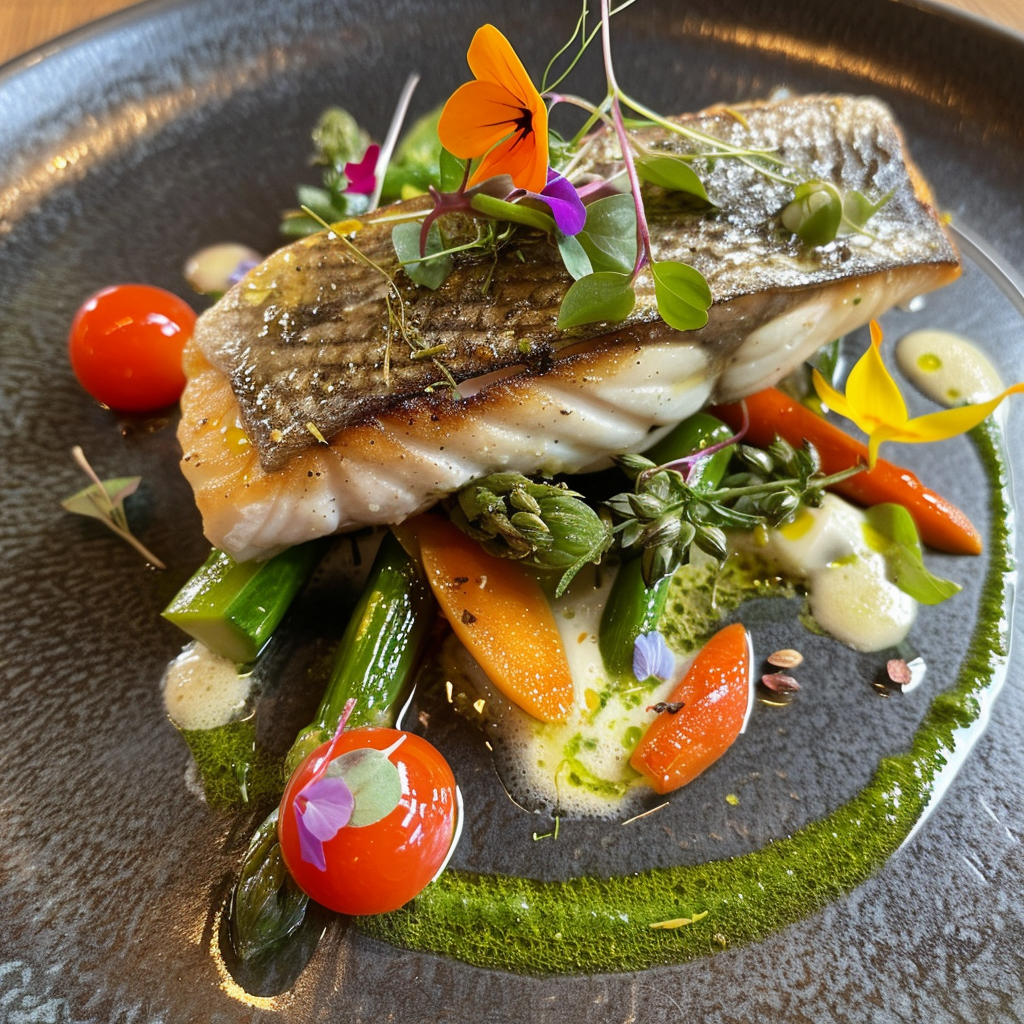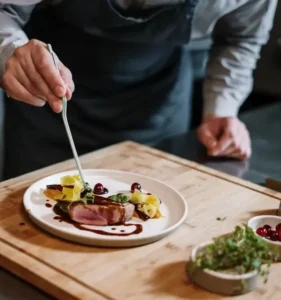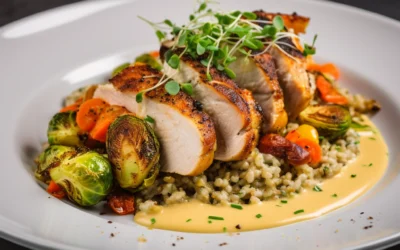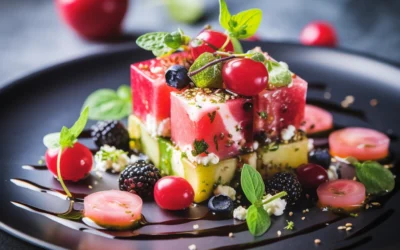Ingredients
For the Seabream:
2 fresh seabream fillets
2 tablespoons olive oil
Salt and pepper to taste
1 lemon, sliced for garnish
Fresh herbs (such as thyme or parsley) for garnish
For the Seasonal Vegetables:
1 bunch of seasonal vegetables (such as asparagus, baby carrots, zucchini, and cherry tomatoes)
2 tablespoons butter
2 cloves garlic, minced
Salt and pepper to taste
1 tablespoon lemon juice
For Lemon Butter Sauce:
4 tablespoons unsalted butter
2 cloves garlic, minced
Zest of 1 lemon
Juice of 1 lemon
2 tablespoons dry white wine (optional)
Salt and pepper to taste
2 tablespoons chopped fresh parsley
Instructions
Prepare the Seabream:
Preheat the oven to 375°F (190°C).
Rinse the seabream fillets under cold water and pat them dry with paper towels.
Season both sides of the seabream fillets with salt and pepper.
Heat olive oil in a large oven-safe skillet over medium-high heat.
Once the oil is hot, add the seabream fillets to the skillet, skin-side down. Cook for 3-4 minutes until the skin is crispy and golden brown.
Carefully flip the fillets using a spatula and cook for an additional 2-3 minutes.
Transfer the skillet to the preheated oven and bake for 5-7 minutes, or until the fish is cooked through and flakes easily with a fork.
Prepare the Seasonal Vegetables:
While the fish is baking, prepare the vegetables. Trim and clean the vegetables as needed.
In a large skillet, melt the butter over medium heat.
Add minced garlic to the skillet and sauté for 1-2 minutes until fragrant.
Add the seasonal vegetables to the skillet and season with salt and pepper to taste.
Cook the vegetables for 5-7 minutes, stirring occasionally, until they are tender but still crisp.
Remove the skillet from heat and drizzle lemon juice over the vegetables. Toss gently to coat.
Assemble the Dish:
Carefully remove the seabream fillets from the oven and transfer them to serving plates.
Arrange the seasonal vegetables alongside the seabream fillets.
Garnish with lemon slices and fresh herbs.
Prepare the Sauce:
In a small saucepan, melt the butter over medium heat.
Add the minced garlic to the melted butter and sauté for 1-2 minutes until fragrant.
Pour in the white wine (if using) and allow it to simmer for 1-2 minutes to cook off the alcohol.
Stir in the lemon zest and lemon juice, then season with salt and pepper to taste.
Reduce the heat to low and let the sauce simmer gently for 2-3 minutes to allow the flavors to meld together.
Taste the sauce and adjust the seasoning if needed.
Serve:
Once the seabream and seasonal vegetables are cooked and plated, spoon the lemon butter sauce over the fish and vegetables.
Garnish with microherbs.
Serve immediately while the sauce is warm and enjoy the harmonious blend of flavors.
Chef’s Tip:
If you prefer a smoother consistency for the sauce, you can strain it through a fine mesh sieve before serving to remove any solid bits of garlic or lemon zest. Additionally, feel free to customize the sauce by adding a pinch of red pepper flakes for a hint of heat or a splash of heavy cream for extra richness.
Serving/Nutritional Facts
Seabream Fillet (150g):
Calories: 200 kcal
Protein: 40g
Fat: 3g
Carbohydrates: 0g
Fiber: 0g
Sodium: Varies based on seasoning
Seasonal Vegetables (150g serving):
Calories: 50 kcal
Protein: 2g
Fat: 2g
Carbohydrates: 10g
Fiber: 4g
Sodium: Varies based on seasoning
Lemon Butter Sauce (2 tablespoons):
Calories: 120 kcal
Protein: 0g
Fat: 14g
Carbohydrates: 1g
Fiber: 0g
Sodium: Varies based on seasoning
Total Nutritional Facts (per serving):
Calories: Approximately 370 kcal
Protein: Approximately 42g
Fat: Approximately 19g
Carbohydrates: Approximately 11g
Fiber: Approximately 4g
Sodium: Varies based on seasoning and personal preference
Overall Time of Preparation & Other Info
Preparation Time:
Preparing the Seabream: 5-10 minutes (including seasoning and preheating the oven)
Preparing the Seasonal Vegetables: 10-15 minutes (washing, trimming, and chopping)
Making the Lemon Butter Sauce: 5-7 minutes (melting butter, sautéing garlic, and combining ingredients)
Cooking Time:
Cooking the Seabream: 10-15 minutes (including stovetop searing and oven baking)
Cooking the Seasonal Vegetables: 5-7 minutes (sautéing or roasting)
Simmering the Lemon Butter Sauce: 5 minutes
Total Time:
Preparation Time: Approximately 20-30 minutes
Cooking Time: Approximately 20-30 minutes
Overall Total Time: 40 to 60 mminutes
History and Background:
Seabream, also known as “Dorade” or “Sparus aurata,” has been cherished in culinary traditions around the world for centuries. With its mild, sweet flavor and tender flesh, seabream has found its way onto the menus of upscale restaurants and fine dining establishments. Its history is intertwined with coastal cuisines, where it has been celebrated for its versatility and ability to pair well with a variety of ingredients.
The pairing of seasonal vegetables with seabream reflects a commitment to freshness and sustainability—a hallmark of Michelin-starred cuisine. This practice emphasizes the use of locally sourced, in-season produce to enhance flavors and support local farmers and producers. The Lemon Butter Sauce adds a touch of indulgence, marrying the delicate flavors of the fish and vegetables with a rich, tangy finish.
Home Cooking Advice:
While the prospect of preparing a Michelin-inspired dish may seem daunting, with a few key techniques and a focus on quality ingredients, home cooks can achieve remarkable results. Here are some tips to elevate your home cooking experience:
Selecting Fresh Ingredients: Begin with the freshest ingredients available. When purchasing seabream, look for firm, shiny fillets with a clean smell of the sea. Choose seasonal vegetables that are vibrant in color and free from blemishes.
Proper Seasoning: Seasoning is key to enhancing the natural flavors of the dish. Use high-quality sea salt and freshly ground black pepper to season the seabream and vegetables generously.
Precision Cooking: Pay attention to cooking times and temperatures to ensure that the seabream is cooked to perfection—crispy on the outside and tender on the inside. Avoid overcooking, as this can result in dry, tough fish.
Balanced Flavors: Strive for balance in flavors and textures. The Lemon Butter Sauce should be tangy and velvety, complementing the sweetness of the seabream and the freshness of the vegetables without overpowering them.
Home Cooking Michelin Style:
Achieving Michelin-starred quality in home cooking is not about replicating complex techniques or extravagant presentations; rather, it’s about attention to detail, finesse, and a commitment to excellence. Here’s how you can bring a touch of Michelin magic to your home kitchen:
Plating Presentation: While home cooks may not have access to elaborate plating tools, they can still create visually appealing presentations. Arrange the seabream fillets and seasonal vegetables on the plate with care, paying attention to color contrast and balance.
Garnishes and Accents: Elevate the presentation of the dish with thoughtful garnishes and accents. A sprig of fresh herbs or a slice of lemon adds a pop of color and freshness, while a drizzle of balsamic reduction or a sprinkle of microgreens can add sophistication.
Attention to Detail: Michelin-starred chefs are known for their meticulous attention to detail. Take the time to ensure that each component of the dish is cooked to perfection and plated with precision. Small touches, such as wiping the rim of the plate for a clean presentation, can make a big difference.
Tips and Tricks of Cooking this Dish:
To master the art of preparing Seabream with Seasonal Vegetables and Lemon Butter Sauce, consider the following tips and tricks:
Searing the Seabream: Achieve a crispy skin on the seabream fillets by ensuring that the skillet is hot before adding the fish. Pat the fillets dry with paper towels to remove excess moisture, which can prevent proper browning.
Timing is Everything: Coordinate the cooking of the seabream, vegetables, and sauce to ensure that everything is ready to be served simultaneously. Use a timer and trust your instincts to avoid overcooking.
Adjust Seasoning to Taste: Taste and adjust the seasoning of the Lemon Butter Sauce according to your preferences. Add a splash of white wine for extra acidity or a pinch of sugar to balance the flavors if needed.
Seabream with Seasonal Vegetables and Lemon Butter Sauce offers a glimpse into the world of Michelin-starred cuisine, showcasing the beauty of simplicity and the importance of quality ingredients. By following the tips and techniques outlined above, home cooks can embark on a culinary adventure that celebrates flavor, elegance, and the joy of cooking. Whether enjoyed as a special occasion meal or a weeknight indulgence, this dish is sure to impress and delight.
The Sea’s Bounty: Seabream Unveiled
Let’s start with the star of the show: the seabream. With its silvery skin and tender flesh, seabream has long been cherished by chefs and food enthusiasts alike. But what sets this fish apart? It’s not just its delicate flavor or versatility in the kitchen—it’s also its rich history and ecological significance.
Seabream, often referred to as the “king of the sea,” is a species that inhabits the pristine waters of coastal regions around the world. Its journey from ocean to plate is a testament to sustainable fishing practices and the importance of preserving marine ecosystems. Whether grilled, baked, or pan-seared, seabream offers a canvas for culinary creativity, allowing chefs to showcase its natural flavors while complementing it with a variety of ingredients.
Seasonal Splendor: Celebrating the Harvest
Accompanying the seabream is a colorful array of seasonal vegetables—a celebration of nature’s bounty and the changing seasons. From crisp asparagus spears to vibrant cherry tomatoes, each vegetable brings its own unique flavor and texture to the dish, creating a harmonious symphony of tastes and colors.
But seasonal cooking is more than just a culinary trend—it’s a philosophy that honors the rhythm of nature and the interconnectedness of food and environment. By embracing seasonal ingredients, we not only support local farmers and producers but also savor the freshest flavors and nutrients that nature has to offer.
The Elixir of Indulgence: Lemon Butter Sauce Unleashed
No culinary journey would be complete without a sauce to tie it all together, and the Lemon Butter Sauce does just that. With its velvety texture and tangy flavor, this sauce elevates the dish to new heights of indulgence, adding richness and depth to every bite.
But what makes this sauce truly special? It’s the balance of flavors—the zing of fresh lemon, the richness of butter, and the subtle hint of garlic—all coming together in perfect harmony. Whether drizzled over the seabream or spooned onto the seasonal vegetables, the Lemon Butter Sauce is the crowning glory of this culinary masterpiece.
Unlocking the Secrets: Tips from the Experts
Now that we’ve explored the essence of Seabream with Seasonal Vegetables and Lemon Butter Sauce, let’s dive into some insider tips from the culinary experts:
Quality is Key: Start with the freshest ingredients available, sourcing sustainably caught seabream and locally grown seasonal vegetables for optimal flavor and quality.
Preparation is Paramount: Take the time to properly prepare and season the seabream and vegetables, ensuring that each component is cooked to perfection and seasoned to taste.
Technique Matters: Pay attention to cooking techniques, from searing the seabream to sautéing the vegetables and simmering the sauce, to achieve the desired flavors and textures.
Presentation is Everything: Elevate the dish with thoughtful plating and garnishes, creating a feast for the eyes as well as the palate.
Seabream with Seasonal Vegetables and Lemon Butter Sauce is a culinary masterpiece that celebrates the beauty of nature, the artistry of cooking, and the joy of sharing a delicious meal with loved ones. With its rich flavors, vibrant colors, and indulgent sauce, this dish is sure to delight food enthusiasts and inspire home cooks to embark on their own culinary adventures. So gather your ingredients, sharpen your knives, and prepare to savor the symphony of flavors that awaits!
Creating a gluten-free and lactose-free version of Seabream with Seasonal Vegetables and Lemon Butter Sauce is entirely feasible without compromising on flavor or quality. Here’s how you can adapt the recipe to accommodate these dietary restrictions:
Gluten-Free Adaptation:
Seabream: Ensure that the seabream fillets are naturally gluten-free. Most fresh fish is inherently gluten-free, but it’s always a good idea to double-check if you’re purchasing pre-packaged or marinated fish.
Seasonal Vegetables: Stick to naturally gluten-free vegetables such as asparagus, baby carrots, zucchini, and cherry tomatoes. Avoid using any pre-made seasoning blends or sauces that may contain gluten. Opt for fresh herbs, olive oil, salt, and pepper for seasoning.
Lemon Butter Sauce: The Lemon Butter Sauce can easily be made gluten-free by using a gluten-free substitute for the white wine (if using) and ensuring that the butter is gluten-free. Most pure butter is gluten-free, but it’s essential to check the label to confirm. You can also substitute white wine vinegar or gluten-free chicken broth for the white wine.
Lactose-Free Adaptation:
Seabream: Seabream is naturally lactose-free, so no modifications are necessary for the fish itself.
Seasonal Vegetables: Use lactose-free butter or olive oil instead of regular butter for sautéing the vegetables. Many brands offer lactose-free butter alternatives made from vegetable oils.
Lemon Butter Sauce: Substitute lactose-free butter or a dairy-free margarine for the regular butter in the Lemon Butter Sauce. Additionally, ensure that the lemon juice and any other ingredients used in the sauce are lactose-free.
Additional Tips:
Ingredient Label Reading: Always read the labels of packaged ingredients carefully to ensure they are gluten-free and lactose-free. Look out for hidden sources of gluten and lactose, such as certain sauces, seasonings, and pre-packaged foods.
Kitchen Cleanliness: When cooking for individuals with gluten intolerance or lactose intolerance, it’s crucial to maintain a clean cooking environment to prevent cross-contamination. Use separate utensils, cutting boards, and cooking surfaces for gluten-free and lactose-free ingredients.
Communication: If you’re cooking for guests with dietary restrictions, communicate openly with them about their specific needs and preferences. They will appreciate your efforts to accommodate their dietary requirements and ensure an enjoyable dining experience for everyone.
By making these simple adjustments and being mindful of ingredient choices, you can create a delicious, gluten-free, and lactose-free version of Seabream with Seasonal Vegetables and Lemon Butter Sauce that everyone can enjoy.
Entertainment
In a quaint coastal village nestled between rugged cliffs and the shimmering sea, there lived a talented young chef named Alessandro. Renowned for his culinary prowess and creative flair, Alessandro ran a small but charming restaurant called “Seaside Haven,” where locals and travelers alike gathered to savor his delectable creations.
One crisp autumn morning, as the village bustled with the energy of the changing season, Alessandro received a mysterious package at his doorstep. Intrigued, he carefully unwrapped it to reveal the freshest seabream fillets he had ever laid eyes on, accompanied by a colorful assortment of seasonal vegetables and a handwritten note that read: “For the maestro of flavors, with compliments from an admirer.”
Eager to showcase the exquisite ingredients, Alessandro set to work crafting a dish that would enchant his guests and honor the bounty of the sea and land. With meticulous care, he seasoned the seabream fillets with a delicate touch of sea salt and cracked black pepper, then seared them to perfection until the skin crackled and crisped, releasing a tantalizing aroma that filled the kitchen.
Meanwhile, Alessandro transformed the vibrant seasonal vegetables into a symphony of colors and textures, blanching the asparagus, roasting the baby carrots to caramelized perfection, and sautéing the zucchini and cherry tomatoes until they glistened like jewels.
But it was the pièce de résistance—the Lemon Butter Sauce—that truly elevated the dish to culinary perfection. With a deft hand, Alessandro melted butter in a pan, infusing it with the essence of freshly minced garlic and the zest of ripe lemons. As the sauce simmered and thickened, it filled the air with an intoxicating fragrance that drew in passersby from the cobblestone streets.
As the sun dipped below the horizon and the candles flickered in the cozy dining room of Seaside Haven, Alessandro emerged from the kitchen, carrying platters adorned with his masterpiece: Seabream with Seasonal Vegetables and Lemon Butter Sauce. With each bite, guests were transported on a journey of flavors—the delicate sweetness of the seabream, the earthy richness of the vegetables, and the bright tang of the lemon butter sauce dancing across their palates in perfect harmony.
As the evening unfolded, Alessandro’s mysterious admirer revealed herself—a traveling food critic who had heard whispers of his culinary genius and wished to experience it firsthand. With tears of joy in her eyes, she declared Alessandro’s dish a masterpiece worthy of the highest accolades—a symphony of flavors that stirred the soul and left a lasting impression on all who tasted it.
And so, in the heart of a quaint coastal village, amidst the crashing waves and salty sea air, Alessandro’s Seabream with Seasonal Vegetables and Lemon Butter Sauce became legend—a culinary masterpiece that celebrated the beauty of the sea, the bounty of the land, and the artistry of a talented chef’s imagination.



 I’m Byron Ella, hailing from the beautiful Philippines. My culinary journey began as a commis galley with Crystal Cruises back in 2016, where I honed my skills and passion for the art of cooking. Transitioning to Seabourn Cruiselines, I embraced the role of a Demi Chef de Partie, delving deeper into the intricate world of gourmet cuisine.
I’m Byron Ella, hailing from the beautiful Philippines. My culinary journey began as a commis galley with Crystal Cruises back in 2016, where I honed my skills and passion for the art of cooking. Transitioning to Seabourn Cruiselines, I embraced the role of a Demi Chef de Partie, delving deeper into the intricate world of gourmet cuisine. 

